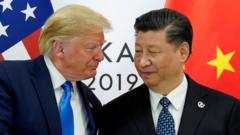Analyzing China's readiness to withstand the pressures of a trade war with the US reveals both its considerable domestic market potential and its monopoly on critical resources, particularly rare earths, setting the stage for a prolonged economic battle.
The Strategic Hand: China's Countermeasures in the Trade War with the US

The Strategic Hand: China's Countermeasures in the Trade War with the US
As the trade conflict intensifies, China reveals key strategies it may deploy to combat US tariffs and economic pressure.
China's escalating trade war with the US has transformed into a fierce economic showdown, characterized by soaring tariffs that could reach 245% on Chinese goods and a reciprocal 125% on US imports. Both nations are bracing for an unpredictable economic future amid fears of a global recession. Despite Washington's pressure, Chinese President Xi Jinping has maintained a firm stance, declaring a willingness to “fight to the end” while keeping the door to dialogue ajar.
Central to Beijing’s strategy is its ability to endure economic strain better than smaller nations. With over a billion consumers, China has the potential to alleviate trade losses by tapping into a vast domestic market. Nonetheless, significant domestic consumption remains sluggish, prompting government incentives to boost spending, which could be spurred significantly by the tariffs' pressures. Analysts theorize that the ruling Communist Party might endure hardship to avoid yielding to perceived US aggression, strengthened further by its lack of electoral pressures typically faced in democratic structures.
Resilience in the face of US tariffs extends beyond domestic markets. China has been funneling money into innovative sectors, increasingly expanding into electric vehicles and artificial intelligence technology. As its global manufacturing profile evolves, it faces decreasing competition challenges from American brands, highlighted by a significant leap in home-grown tech firms which are capturing market share from established entities like Apple.
Moreover, China’s Belt and Road Initiative illustrates its proactive approach to mitigate reliance on the US, establishing stronger trading relations with Southeast Asia, Latin America, and Africa. This initiative has coincided with a decisive reduction in soy imports from the US, shifting towards domestic production and bolstered supply from Brazil, the largest soybean supplier.
Additionally, experts suggest that the Chinese government, which holds an estimated $700 billion in US treasuries, possesses a strategic leverage point. While speculation of selling or withholding these bonds circulates, financial analysts caution that doing so could bring adverse consequences for China's economy, making such a “weapon” a double-edged sword.
Furthermore, China maintains near-monopoly control of rare earth minerals—essential resources for technology and manufacturing. With its dominance accounting for 61% of global production and a staggering 92% of global refining capabilities, the country has already exercised this influence by limiting exports of certain crucial elements used in technology and defense sectors.
As the implications of the trade war evolve, China's strategic use of its domestic consumer market, commitment to technological advancements, and control over key resources position it uniquely against the US, suggesting that returning to a pre-war economic state may be far more complex than either nation anticipates.






















